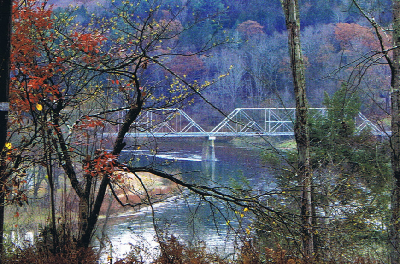
Can Skinners be Saved?
June 17, 2023
DRBC: Allow Remote Participation for Public Comments
June 20, 2023You can submit your comment to restore and save the Bridge by June 25 (directions below).
Our treasured, and currently closed, Skinners Falls – Milanville Bridge (the Bridge) is essentially on trial for its life. PennDOT, the lead agency and part of the judging team that will decide its fate, has finally had its contractor, AECOM, complete and released the assessment required by federal law when looking to alter a property that is on the Historic –Registry. The bridge is not only on the registry—twice over– but also part of the Delaware River’s Wild and Scenic River designation.
No High Volume Hydraulic Fracture shale drilling can happen in NY state, nor anywhere in the Delaware River Basin. In addition, discharge of drilling waste into the Delaware Basin is now forbidden (DCS sued recently to change/clarify that). all of which I believe changes the chemistry of the Bridge discussions. Without the possibility of large waste or drilling materials trucks to use the Bridge, its historical, cultural, community value come into clearer focus. Previous commenting showed the community saw the Bridge as a vital anchor to its identity and history—its beauty a local marvel and tourist attraction.
According to Nels Raynor, President, Bach Ornamental and Structural Steel Inc.:
I would like to express strong support for the restoration and preservation of the historic Skinners Falls Bridge over Delaware River. This bridge is an extremely rare example of a multi-span pin-connected Baltimore truss bridge. It is among the oldest known bridges associated with the American Bridge Company, having been built shortly after the company’s formation. The bridge is also ornately decorated, including portal knee bracing decoration, portal cresting, decorative builder plaque. There are also original lattice railings that are 20 inches in height and which feature beautiful decorative flower motifs. This is to say nothing of the geometric beauty of the complex Baltimore truss configuration combined with the complexity of the riveted built-up beams that contain v-lacing and lattice.
He also says that with proper restoration,”this bridge could serve for many decades more with minimal future maintenance costs.”
Now the AECOM Historic Bridge Rehabilitation Analysis Phase 1 has been published (here and on DCS’ website), which explores whether it is possible to restore the Bridge without losing its historic aspects:
…in compliance with the Secretary of Interior’s Standards for Rehabilitation. This report also evaluates whether the proposed rehabilitation options would result in adverse effects under Section 106 of the National Historic Preservation Act (NRHP)
The analysis’s conclusion is that YES! the Bridge is restorable keeping its historic character right up to its original 10-ton capacity for a 25-year design life (longer according to Raynor, with proper maintenance).
Liam Mayo’s excellent article in last weeks’ River Reporter has much pertinent detail and history. We here want to emphasize the importance of the public making its views known (yes, we know, AGAIN!) how much and in what way the Bridge in its historic state means to us.
From the Analysis:
As a federally-funded project, Section 106 of the National Historic Preservation Act (NHPA) [which interlocks with the National Environment6al Policy Act (NEPA)] requires the lead agency to take into account the effects of their project on any National Register-listed or eligible properties in the APE. … The Area of Potential Effect (APE) encompasses the footprint of the bridge and the overhead clearance portal frames… There are two resources within this APE: the Skinners Falls Bridge and the Milanville Historic District.
HERE’s where you come in: Both NEPA and NHPA have public input as crucial components of the decision-making process. PennDOT is asking for comments before June 25, simply emailed to hgerling@pa.gov (and please copy DCS@damascusCitizens.org). You can probably re-use the comments you filed before. If you had copied DCS we have them, and can return them to you if you ask us.
Heather Gerling, Architectural Historian, now the contact person, asks that commenters:
… become formal consulting parties on the project [if not already] so we can keep track for our Section 106 records, and so we have their information to send them updates directly. GO HERE.. Click “become a consulting party” and fill in the form. If that doesn’t work email hgerling@pa.gov, with your name, address, and email, and I can get them entered in.
Barbara Arrindell, Director
Damascus Citizens for Sustainability
Narrowsburg, NY
Download this Blog post as a pdf.
Read this My View in The River Reporter.




